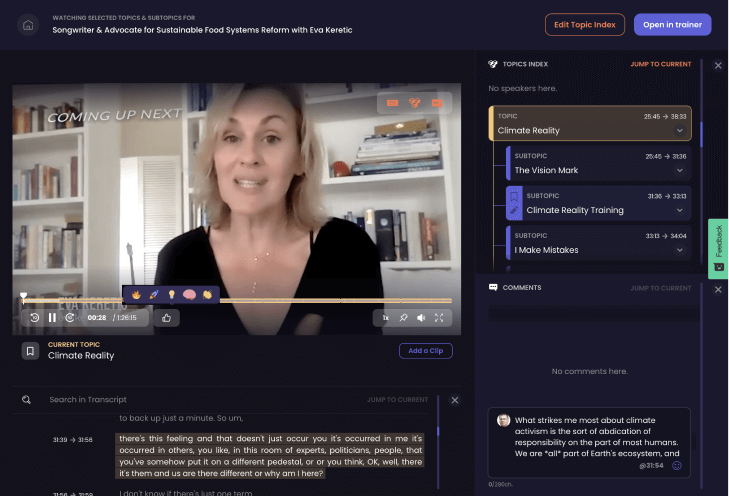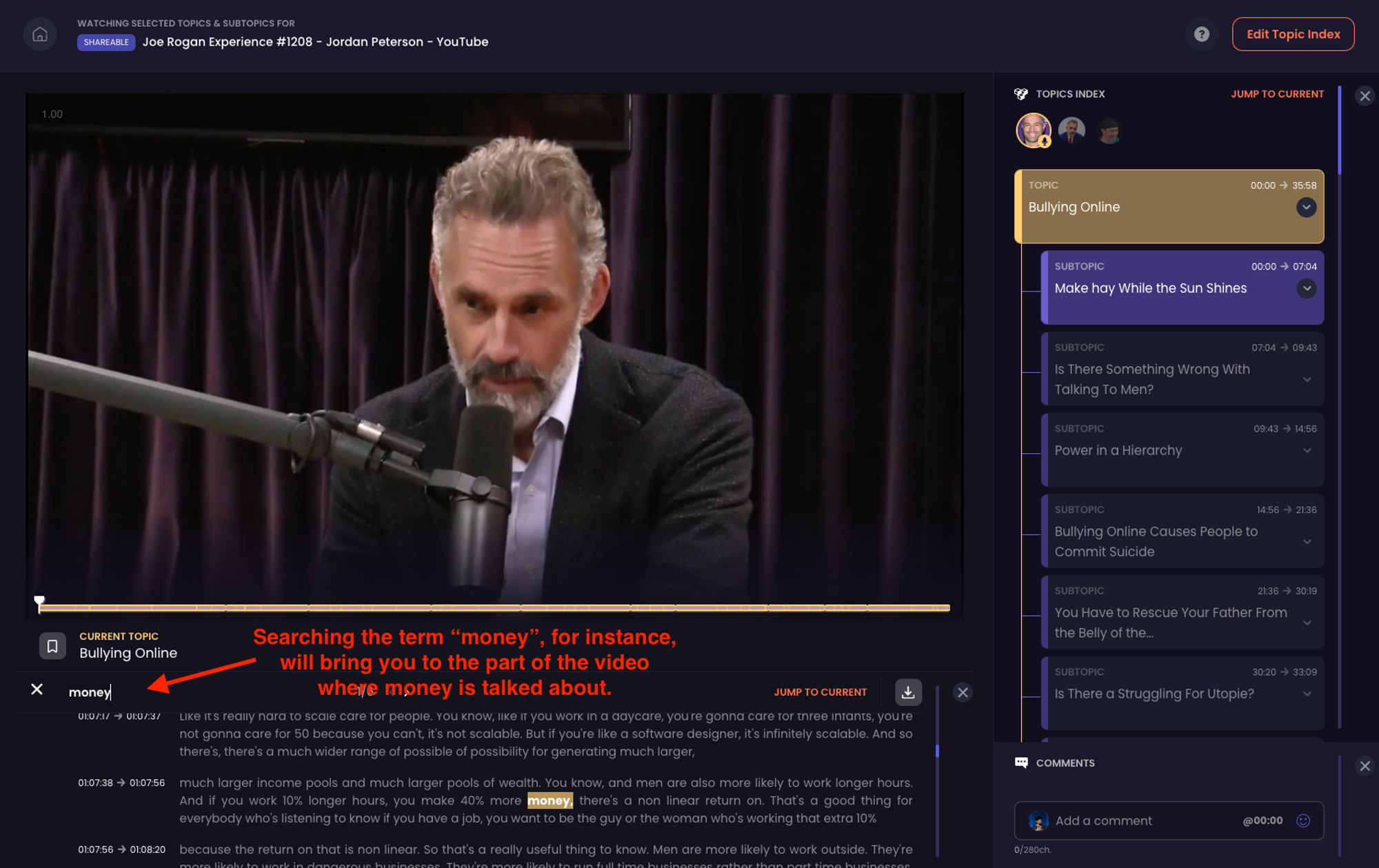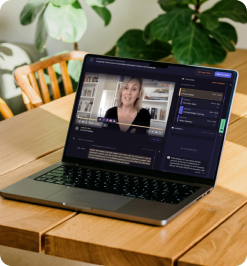
How to Record a Video Podcast in 6 Steps (Equipment + Apps)
Get your blueprint for podcasting success with insider tips, essential equipment, and top software choices.
Overview
Ever wondered why some video podcasts feel like a breeze to watch, while others seem to drag on? The secret isn't just what you say, but in how you present it. The best way? Video.
As of May 2023, the number of video podcasts on the internet has soared to over 50,800. This staggering growth highlights the opportunity for your video podcast to stand out in this rapidly expanding space.
In this article, we'll guide you through:
- Step-by-step instructions to record your video podcast.
- Insider tips and best practices that give your content an edge.
- The must-have equipment to elevate your recording quality.
- Top software and apps that streamline your podcasting process.
- How to edit and publish your podcast efficiently for maximum impact.
P.S., while you're mastering these steps, don't forget to check out CLIPr. This advanced VAM platform is more than just a tool – it's your podcast's new best friend. With CLIPr's AI-driven indexing and other editing tools, you can ensure your podcast not only reaches but also deeply resonates with your audience.
{{cta}}

What is a Video Podcast?
A video podcast, also known as a "vodcast", combines the engaging elements of a traditional audio podcast with visual content. Generally, it takes the form of a video recording of the podcasters while they record an episode.
This format allows for a more dynamic interaction, where your expressions, visuals, and on-screen graphics add depth to your storytelling. In today's digital era, video podcasts are becoming an increasingly popular medium, offering a richer, more immersive way to connect with viewers.
3 Reasons Why Video Podcasts Are Trending
In the digital media landscape, video podcasting is a game-changer that can make your podcast stand out. Let’s dive into why it’s capturing the spotlight.
1. Wider Audience Reach
- A study by Morning Consult reveals that 46% of avid podcast listeners now prefer video over podcast audio-only formats. Especially among younger demographics like Gen Z and millennials, video podcasts are the new go-to.
- This preference opens up new avenues for content creators to reach a broader, more diverse audience, tapping into the visual-centric culture of these younger generations.
2. Platform Versatility
- Video platforms like YouTube, TikTok, and even Apple Podcasts are transforming how we share and consume podcasts. With options to upload snippets and full episodes, these platforms make podcasts more accessible.
- One in three podcast fans now chooses YouTube for their podcast fix, moving away from traditional audio-supporting platforms.
3. Meeting the Demand for Dynamic Content
- The rise of video podcasts reflects a desire for content that's not just heard but seen and felt. In today's digital age, where video production tools are increasingly accessible, content creators are uniquely positioned to craft experiences that are not just auditory but also visually captivating and emotionally resonant.
- This shift towards multi-sensory content meets the audience's growing demand for richer, more immersive experiences.
A Step-by-Step Guide to Creating Your First Video Podcast
Embarking on your video podcast journey? You're in the right place. Crafting a captivating video podcast isn't just about hitting the record button; it's an art that blends creativity with technology.
From setting up your space to hitting publish, each step in your podcast strategy is crucial in turning your vision into a reality.
Now, let's dive into the steps to record and post your first video podcast, ensuring you start on the right foot and make a lasting impression.
Step 1: Plan Your Video Podcast Strategy
A well-planned podcast is like a roadmap for your content journey. It guides what to discuss, how to structure your podcast episodes, and ensures alignment with your audience's expectations.
Define Your Niche
First, pinpoint the theme of your podcast. Whether it's technology, lifestyle, comedy, or something unique, defining your niche is crucial in establishing a distinct voice in the crowded podcasting arena. This clarity helps craft video episodes that align with your vision and audience's expectations.
Choose Your Podcast Format
The choice of video format plays a pivotal role in how your audience engages with your podcast. Let's explore the most popular types, each offering unique advantages:
- Static Image Podcasts: Best for creators starting out or focusing on strong audio content. These podcasts pair your audio with a compelling, static image, like logos or thematic graphics. Great for storytelling or monologue-style podcasts where the visual element is not the primary focus but adds a branded touch.
- In-Studio Podcasts: Ideal for high-quality, professional podcast productions. These offer a polished, visually engaging setup. Perfect for tech or business podcasts where the environment contributes to the credibility and immersive experience.
- Solo Recording Podcasts: Remote recording is great for personal, opinion-based, or expertise-driven content. Focuses on a single host, delivering a direct, intimate connection with the audience. Effective for motivational or educational content where personal insight is key.
- Remote Interview Podcasts: Remote interview recording is ideal for connecting with guests from various locations. These use online tools for interviews, expanding your guest list without geographical limits. Suitable for discussion-driven podcasts where diverse viewpoints are highlighted.
- Footage and Audio Podcasts: Good for narrative-rich content or documentaries. These combine recorded footage with compelling audio clips. Excellent for history, travel, or documentary-style podcasts where visual storytelling enhances the listener's experience.
Know Your Audience
Understanding who you're talking to is vital. Tailor your content to their interests. For a tech podcast, this might mean focusing on the latest gadgets. Use tools like Google Trends to stay up-to-date on what your audience is currently interested in.
Pro Tip: Outline your first 10 episodes in advance. This foresight not only offers a clear direction but also ensures content consistency. Use organizational tools like Trello or Asana for efficient planning.
Step 2: Choosing the Right Equipment
The right podcast equipment is vital in producing a high-quality video podcast. Your choice of gear can drastically affect the final output, influencing both audio and visual quality. Here is some necessary gear to start a video podcast:
Cameras
Select a camera that fits your budget and technical requirements.
- For beginners, a high-quality webcam or a smartphone with a good camera can suffice.
- However, for more professional results, consider investing in a DSLR or mirrorless camera.
Look for features like HD or 4K resolution, good low-light performance, and autofocus capabilities for quality video recording.
Microphones
Audio quality can make or break your podcast. A poor microphone can distract your audience, no matter how compelling your content is. So, having the best audio recording tools is a must.
- USB microphones are a good starting point for their ease of use and affordability.
- For higher sound quality, consider XLR microphones, which require an audio interface but offer superior audio quality.
Remember, the right microphone depends on your recording environment and the type of content you produce.
Lighting
Good lighting is crucial in video podcasting. It not only enhances the video quality but also sets the tone and mood of your content. Start with a basic three-point lighting setup: a key light, a fill light, and a backlight. This setup reduces shadows and evenly distributes light, making your footage look professional. Adjustable LED ring lights are a popular and affordable option.
Additional Equipment
Enhancing the video element of your podcast goes beyond just the camera and microphone. Here's some additional equipment that can significantly improve the quality of your podcast recordings:
- Tripods and Stands: Essential for stabilizing your camera and microphones.
- Soundproofing: Acoustic panels or foam can greatly improve sound quality by reducing echo and background noise.
- Headphones: For monitoring audio quality during recording.
- Pop Filters: These can reduce or eliminate popping sounds in speech.
Pro Tip: Investing in quality equipment is a crucial step in your video podcasting journey. It's not about having the most expensive gear but choosing the right tools that meet your specific needs and enhance the podcast quality.
Step 3: Setting Up Your Recording Space
Creating the right recording space is crucial for a high-quality video podcast. This space impacts not just the technical aspects of your recording but also the overall ambiance of your podcast episode.
- Finding the Ideal Location: Choose a location where you can manage sound and lighting, and record video away from external noises. A spare room or a dedicated corner in your home can become your studio. If planning to record with guests, ensure the space is ample for multiple people, maintaining comfort and visual appeal.
- Optimizing Sound: Use rugs and soft furnishings to absorb sound and minimize echo. Acoustic panels or foam can be a game-changer. Position your microphone correctly with pop filters to ensure clear audio, crucial for both solo recordings and in-person discussions.
- Perfecting Lighting: Utilize natural light but avoid harsh shadows. Implement a three-point lighting setup for a consistent, professional look. Adjust the color temperature of your lights to set the right mood for your podcast, be it energetic or intimate.
- Appealing Background: Choose a background that resonates with your podcast's theme. A static image recording, short looping video or carefully arranged set can make a significant difference. Keep it uncluttered yet personal. Artwork, colors, or props can add character without being distracting.
- Ergonomics and Comfort: Ensure your furniture is comfortable for long recording sessions. Arrange your equipment ergonomically for easy access and functionality. This is especially important for lengthy podcast episodes or extended in-studio recordings.
Setting up your recording space isn't as easy as just finding a room; it’s about crafting an environment that enhances both your audio and video quality. This space will not only be a functional area for recording but also a reflection of your podcast's identity, adding a personal touch to every episode you create.
Step 4: Recording the Video
Now that your space is ready, it's time to dive into the heart of your podcast: the recording process. Combining the right techniques and tools is key to making your video recordings stand out.
- Camera Placement and Angles: Position your camera at eye level and use the Rule of Thirds for a natural and dynamic composition. To record remote interviews, consider multiple cameras to capture various angles, adding visual interest and keeping viewers engaged.
- Ensuring Audio Quality: Position your microphone correctly to capture clear audio while keeping it out of the camera's frame. It’s crucial to minimize ambient sounds and continuously monitor the audio for clarity, especially during remote podcast recordings.
- On-Camera Presence: Use natural gestures and maintain eye contact with the camera to foster a connection with your audience. Your enthusiasm for the topic will resonate with viewers, making your content more engaging.
- Test and Backup: Conduct test recordings and have a backup system in place to safeguard your content. Keep notes or a script handy, but aim for a conversational tone to start your video podcast on the right note.
- Leveraging Recording Software: Utilize reliable recording software like OBS Studio, video conferencing software like Zoom or Microsoft Teams for remote interviews, or Adobe Premiere Pro for simple edits. These tools not only capture video but also offer features for enhancing your content, making them indispensable for both in-studio and remote recordings.
Recording your video podcast is a combination of technical know-how and personal flair. While the technical aspects ensure a high-quality production, your on-camera presence and recording techniques bring the content to life, making it engaging and memorable for your audience.
Step 5: Edit the Video Podcast
Editing is a crucial step in transforming your raw footage into a polished and captivating video podcast. Use a quality video editing software to fine-tune the content, ensuring it's not only engaging but also delivers your message effectively.
General Editing Workflow
Start with the basics:
- Trimming and Cutting: Remove any unnecessary segments to maintain a brisk, engaging pace.
- Adding Transitions: Smooth transitions between topics or segments keep the viewer's attention.
- Graphics and Text Overlays: These enhance the viewing experience, providing context or highlighting key points.
- Color Correction: Ensure the visual appeal of your podcast with balanced and consistent coloring.
- Sound Editing: Balance audio levels, eliminate background noise, and consider adding music and sound effects for emphasis.
Pro Tips for Enhanced Editing
- Index Your Video: When dealing with lengthy videos, indexing them can be a game-changer. It helps both you and your viewers navigate through the content with ease. Tools like CLIPr offer video indexing to help you identify and concentrate on key topics and subtopics. This ensures that your edits are not only efficient but also perfectly aligned with your podcast's central theme.

- Efficient Navigation of Content: Navigating through extensive recordings can be daunting. This is where efficient content navigation becomes crucial. With CLIPr’s search functionality, you can quickly pinpoint specific parts of your podcast.

Expert Tip on the Final Cut: Once you’re done, review the edited video from start to end. Pay attention to the pacing, ensure the narrative flows smoothly, and watch out for any technical glitches. Sometimes, small adjustments in editing can make a significant difference in the overall quality and impact of your podcast.
{{cta}}
Step 6: Publish Your Video Podcast
Now that your video podcast is finally edited, the next exciting phase is sharing it with the world. This is where your creative efforts meet your audience, and you get to see the fruits of your labor in real-time.
Choosing the Right Platform
- A YouTube channel is indispensable for video podcasters. With its extensive audience base and intuitive interface, YouTube stands as a prime spot for your podcast. But why stop at YouTube?
- Expand your reach by sharing your podcast on various social media platforms like Facebook, Instagram, or Twitter. Each of these platforms caters to different audience segments and offers unique ways to engage and grow your viewer base.
Optimizing for Different Formats
- Not everyone may be in a position to watch your video podcast. Catering to this audience, consider creating an audio-only version of your podcast for platforms like Spotify or Apple Podcasts. This approach ensures you don't miss out on traditional podcast listeners.
- Additionally, generating buzz is key. Use CLIPr's bookmark feature to create and share short teasers or clips on platforms like Instagram or TikTok. These snippets, carefully selected for their engaging content, can drive traffic to your full episodes and broaden your audience reach.

Effective Promotion Strategies
- Your network is a goldmine. Tap into your personal and professional circles to promote your latest episode. Engaging with your audience directly through comments and messages can significantly boost your podcast's visibility.
- Consistency is key in keeping your audience hooked. Stick to a regular posting schedule, so your viewers know when to expect new content from you.
Monitor and Adapt
- Use the analytics tools provided by platforms like YouTube to track your podcast's performance. Key metrics like view count, watch time, and audience demographics offer insights into your content's reach and impact.
- Be open to adapting your content based on viewer feedback. Audience preferences can evolve, and staying attuned to their feedback ensures your content remains relevant and engaging.
Publishing your video podcast is a significant milestone in your journey as a content creator. By strategically using platforms like YouTube, social media, and podcasting sites, and being responsive to audience feedback, you can effectively amplify your reach and make a meaningful impact in the vibrant world of video podcasting.
Streamline Your Podcasting Journey with CLIPr
You've ventured through the essentials of creating a captivating video podcast, each step paving the way to share your story with the world. From setting up your space to editing your masterpiece, these podcasting practices bring you closer to sharing your unique voice with the world. Remember, the journey to a successful podcast is both creative and technical, but most importantly, it's uniquely yours.
Here are your key takeaways:
- Plan and define your podcast's niche and format.
- Set up a recording space that enhances audio and video quality.
- Record with the right techniques for a professional look.
- Edit for clarity, engagement, and narrative flow.
- Publish on the right platforms to reach your audience.
Podcasting is an art, and with CLIPr, it becomes a masterpiece. CLIPr's advanced features, like video indexing and audience engagement insights, are tailor-made to enhance your podcasting journey. Whether you're a seasoned podcaster or just starting out, CLIPr can help transform your video content into an interactive, impactful experience.
{{cta}}
Read Next
CLIPr Your Next Viral Moment in Minutes
Tame video chaos with CLIPr: Navigate through AI-driven chapters, dive into searchable transcripts, and highlight pivotal moments for easy collaboration and content repurposing


